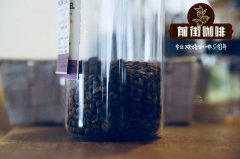Suggestions on the characteristics, flavor and taste of the top coffee brand of St. Roman, Tarazu, Costa Rica

Professional coffee knowledge exchange More coffee bean information Please pay attention to coffee workshop (Weixin Official Accounts cafe_style)
Hand washed costa tala beads san roman. 15g powder, medium grinding (small Fuji ghost tooth knife 4 grinding), v60 filter cup, 88-89 degrees water temperature, the first injection of 30g water volume, 27 seconds stewing, injection to 105g water volume cut off water, wait for the powder bed water volume to drop to half, then inject water slowly until 225g water volume, the tail section does not, water powder ratio 1:15, extraction time 2:00
San Romain treatment plant, the use of washing treatment method based on a strong taste. Coffee cherries are hand-selected, coffee farmers remove overripe or immature cherries, and then production processing, using a 3 disc aagaarde peeling machine to remove the peel and pulp, and then using a machine to divide the coffee beans into three grades according to the density of the beans. Grade 1 and 2 green beans are fermented separately, while grade 3 is low quality green beans. The beans are fermented in a cool place for about 24- 36 hours. After fermentation, the beans are washed and graded according to density again in a washing channel. Then the beans are randomly soaked in clean water overnight. The processed coffee is roasted and has a bitter sweet chocolate flavor with a creamy sweet texture, combined with a low profile wine acidity, a strong aroma and a memorable fruit sweetness of chocolate beans.
Fertile volcanic ash, mild temperatures, and steady rainfall are among the factors that have made coffee a major agricultural product in Colombia. The seven regions are Tarrzu, Tres Rios, Orosi, Central Valley, West Valley, Turrialba and Brunca.
Costa Rica Tara Pearl San Roman Processing Plant Royal Coffee
Costa Rica San Ramon Royal Coffee
Country: Costa Rica Fiscal year: 2003
Grade: SHB
Altitude: 1700M
Production area: Tarazhu production area
Baking Degree: Medium Deep Baking
Treatment method: washing treatment
Breeds: Kadura, Kaduai
Treatment plant: San Romain Treatment Plant
Flavor: Berry fruity, caramel, creamy, slightly spicy
Costa Rica's best coffee seems to come from small processing plants, spread over several major coffee growing regions, including Tara Pearl and Western Valley. The so-called coffee revolution, which began 15 years ago, has dramatically changed the way roasted bean experts and importers think about Costa Rican tarajo coffee. Centered in the processing plant, coffee beans are collected from small farms around, mostly small communities or families, growing coffee on their own small farms or on land, all of which are processed and dried in a small processing plant. Royal Coffee is unique in its quality and flavor, thanks in large part to the cooperation between coffee producers and us.
Costa Rican coffee cultivation was introduced from Cuba in 1779 and exported for the first time in 1820. There are about 32,000 coffee farmers in Costa Rica, with an average cultivation area of less than one hectare (10,000 m2) per farmer. Costa Rica has a population of 4.1 million (2006), 82,500 hectares of coffee cultivation area, an annual production of 1.7 million bags (60kgs per bag), and an annual domestic consumption of 380,000 bags, with an average annual consumption of 5.5 kgs per person, which is higher than Japan's (consumption of 4 kgs).
Costa Rica was the first country to introduce coffee into Central America. It has a long history and a complete coffee organization system from production to sales. Because it is located in the Central American Isthmus, there are many volcanoes in the territory, it has the natural advantages of sunshine and land, and the climate is simultaneously reconciled by the Pacific Ocean and Atlantic Ocean currents and sea breezes. The coffee produced has the characteristics of local micro-climate and terroir conditions. In terms of quality and quantity, Costa Rica's coffee has always been recognized by the world and has been rated as one of the world's high-quality coffees. Costa Rican coffee has been cultivated for 200 years, first planted on the slopes of Poas and Barva volcanoes, today known as the Central Valley (Central Valley), the main seven coffee growing areas are from northwest to southeast, along the inland Central Plateau distribution.
Factory Name: Qianjie Cafe Address: Yandun Road, Dongshankou, Yuexiu District, Guangzhou City Contact: 020-38364473 Shelf Life: 30 Net Content: 227g Packing: Bulk Taste: Aromatic Coffee Bean Ripe Degree: Coffee Ripe Bean Sugar Free Origin: Costa Rica Coffee Type: Costa Rica Tara Beads Coffee Roasting Degree: Moderate Roasting
Flavor Description: Berry fruity, caramel, cream, slightly spicy
Important Notice :
前街咖啡 FrontStreet Coffee has moved to new addredd:
FrontStreet Coffee Address: 315,Donghua East Road,GuangZhou
Tel:020 38364473
- Prev

Which Mexican coffee is good? what are the coffee producers' cooperative estates?
Professional coffee knowledge exchange more coffee bean information Please follow the coffee workshop (Wechat official account cafe_style) when you have a cup of coffee, what do you think of it? Bitter, sour? Catchy, mellow? A cup of coffee, in addition to the enjoyment of the taste, the origin, planting mode and producer story behind it are more for us to savor. Mexico is an exotic place.
- Next

Taste and flavor characteristics of sun-dried coffee beans in Guanacaster Canitas Manor, Costa Rica
Professional coffee knowledge exchange more coffee bean information Please follow the coffee workshop (Wechat official account cafe_style) in recent years, Costa Rican coffee beans due to the improvement of American coffee bean production technology, the flavor performance has greatly changed in the past with only nutty flavor performance, and has become an important production area of fine coffee. Also won in many international coffee competitions.
Related
- Detailed explanation of Jadeite planting Land in Panamanian Jadeite Manor introduction to the grading system of Jadeite competitive bidding, Red bid, Green bid and Rose Summer
- Story of Coffee planting in Brenka region of Costa Rica Stonehenge Manor anaerobic heavy honey treatment of flavor mouth
- What's on the barrel of Blue Mountain Coffee beans?
- Can American coffee also pull flowers? How to use hot American style to pull out a good-looking pattern?
- Can you make a cold extract with coffee beans? What is the right proportion for cold-extracted coffee formula?
- Indonesian PWN Gold Mandrine Coffee Origin Features Flavor How to Chong? Mandolin coffee is American.
- A brief introduction to the flavor characteristics of Brazilian yellow bourbon coffee beans
- What is the effect of different water quality on the flavor of cold-extracted coffee? What kind of water is best for brewing coffee?
- Why do you think of Rose Summer whenever you mention Panamanian coffee?
- Introduction to the characteristics of authentic blue mountain coffee bean producing areas? What is the CIB Coffee Authority in Jamaica?

